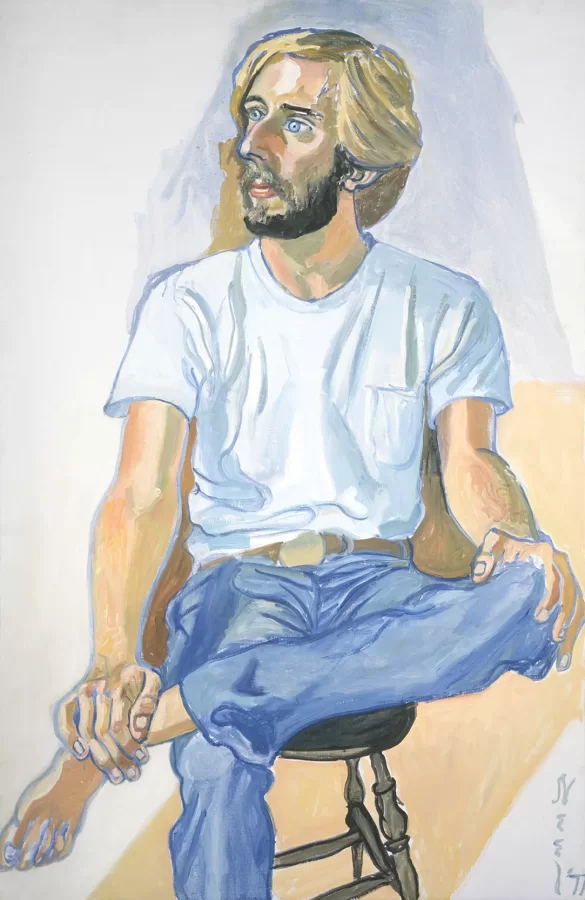Collection Highlight: Stephen Schaefer by Alice Neel

I first saw this portrait of Stephen Schafer by Alice Neel at the Bates Museum of Art when my class Portraiture as a Medium was choosing pieces from the collection for a gallery talk in Winter Semester 2024. I immediately recognized it was an Alice Neel from the loose brush strokes, the expressive and somewhat unnatural color palette, and the flat background emphasizing the figure. I had just come back to Bates from my Junior semester abroad in Copenhagen, Denmark. While studying there, I took a trip to Oslo, Norway where I visited the Munch Museum which happened to have an Alice Neel exhibition on view. I had never heard about her or seen her work before, but became absolutely fascinated with her ability to capture the colorful integrity and diversity of everyday people in New York City. As someone from New York myself, I felt an immediate connection to her work. Through depicting New Yorkers from all walks of life, races, and professions, Neel is able to bring out the raw energy and individuality that makes the city so special. Although I ultimately chose a different work from the collection, I am thrilled to now have another chance to explore this portrait of Stephen Schaefer. It is so exciting to be able to work first hand with a painting by such a renowned woman artist–especially one that I resonated with so strongly while working at the Bates Museum.
Neel is known for her colorful and naturalistic portraits that ooze with the sitter’s personality. This portrait of Stephen Schaefer embodies her signature mark-making defined by a slight distortion, bold outlines, and creative color choice. She lived and worked for twenty years at her apartment in Spanish Harlem, New York.1 In working from home, Neel was able to create a calm, casual, and trusting atmosphere where her sitters could feel comfortable. The sense of comfort is evident in the way her subjects pose. She would talk to her models so that they would ease into a natural positioning. We can see this here through Schaefer’s relaxed body language with his legs crossed and hands resting on his knees. His body is devoid of tension or stiffness; in fact, he is almost slouching over his crossed legs. Although Neel paints his eyes with a piercing blue, his gaze into the distance off the left side of the canvas is calm.
Through capturing Schaefer in a moment of genuine ease rather than a staged performance, this portrait feels refreshingly unposed. Schaefer wears worn-in, classic blue jeans and a loose cotton t-shirt. His unshaven face and bare feet further emphasize the laid-back environment when posing for Neel. He appears to have sat down for the portrait as he was, wearing the clothing he would on any other day. This element of Neel’s work sets her apart from traditional themes in portrait painting. Historically, portraiture was reserved for wealthy or royal patrons. In these works, sitters would wear their finest garb as a means of communicating their financial, social, or political status. Neel, on the other hand, employs portraiture to celebrate ordinary individuals, depicting them in their most authentic state.
Her choice to sometimes distort elements of her subjects, such as Schaefer’s uneven eyes and disproportionately long fingers and toes, reject idealization and highlight humanity and honesty. Her approach pushes the traditional boundaries of portraiture that focus on exhibiting wealth and power by capturing diverse and candid lived experiences of human beings. She also may be referencing early twentieth-century modernist and expressionist styles from Europe through the emotional intensity, abstracted and exaggerated forms, and bold colors.2
By incorporating these influences and references, Neel’s work is unmistakably unique. Even before she rose to fame in the 1960s and 1970s, she made conscious efforts to forge her own identity. Although she was born in Philadelphia, in the 1930s Neel moved to the Greenwich Village Neighborhood in New York City where she painted portraits of artists, left wing writers, and trade unionists.3 However, in 1938, she intentionally distanced herself from the dominant art world centered in Greenwich Village, feeling that it was too insular and trendy among artists, and moved uptown to Spanish Harlem.4 During her time living in Spanish Harlem, and then later the Upper West Side, Neel immersed herself into the everyday lives of working class New Yorkers. Even as she rose to fame during the 1970s and extended her sitters to prominent figures of the time such as Andy Warhol, Robert Smithson, and Frank O’Hara, Neel remained steadfast in her commitment to portraying the complex, real, and dynamic people around her–those often overlooked by traditional portraiture–whether they be her neighbors, notable figures, or strangers.5
- Jason Farago, “Alice Neel’s Love of Harlem and the Neighbors She Painted There ,” New York Times, February 23, 2017, https://www.nytimes.com/2017/02/23/arts/design/alice-neel-harlem.html. ↩︎
- “Biography,” Alice Neel, September 7, 2023, https://www.aliceneel.com/biography/. ↩︎
- Ibid. ↩︎
- Ibid. ↩︎
- Ibid. ↩︎
Bibliography
Als, Hilton. “The Inclusive Humanity of Alice Neel’s Paintings.” The New Yorker, February 4, 2017. https://www.newyorker.com/culture/culture-desk/the-inclusive-humanity-of-alice-neels-paintings.
“Biography.” Alice Neel, September 7, 2023. https://www.aliceneel.com/biography/.
Farago, Jason. “Alice Neel’s Love of Harlem and the Neighbors She Painted There .” New York Times, February 23, 2017. https://www.nytimes.com/2017/02/23/arts/design/alice-neel-harlem.html.
Silver-Cohen, Romy. “Alice Neel (American, 1900-1984).” MoMA, 2021. https://www.moma.org/artists/4253.